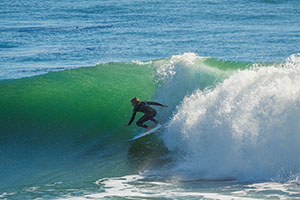| |
Visit Campus Point No-Take State Marine Conservation Area
 Goleta Point - photo copyright Bruce Perry Goleta Point - photo copyright Bruce Perry |
The Campus Point State Marine Conservation Area’s protected waters extend right up to the beach. This marine protected area is known for the many habitat types encompassed within its boundaries and for its close proximity to the UC Santa Barbara campus. From rocky shorelines to sandy beaches and kelp forests to oil seeps, this 10.5 square mile protected zone provides a safe sanctuary to a wide array of species that are representative of the southern California coastline.
Interesting Facts:
- Watch out for tar! Coal Oil Point, a nature reserve administered by UC Santa Barbara, is named for the natural oil fissures offshore. Tar balls that seep from these fissures can be seen washed up on beaches seasonally. Chumash Native Americans used this tar earlier than 1000 A.D. to build canoes and facilitate trades. Campus Point SMCA has significant cultural heritage as well as ecological diversity.
- Campus Point SMCA is considered one of the best places for threatened Western Snowy Plovers. The sandy beaches are “critical habitat” for these birds. They need a place to lay their eggs right on the sand and to find their food of choice—insects that live in and eat the kelp that washes ashore from kelp forests.
- The full list of habitats within and around this SMCA contain over 12 distinct types: including: eelgrass, surfgrass, kelp, rocky reefs, shallow subtidal, rocky intertidal, oil seeps, sand, coastal dune, lagoon, salt marsh, and the Devereux Slough estuarine input.
- Campus Point is designated as a no-take zone—no living resources may be harvested or removed.
 Campus Point Surfing_- photo copyright Barry Rowan Campus Point Surfing_- photo copyright Barry Rowan |
Recreation Opportunities:
- Head to Coal Oil Point for some tidepooling. This is one of the few stretches of rocky intertidal habitat in Campus Point, and it is ranked as the third best tidepooling spot in California’s marine parks:
- Take a hike! UC Santa Barbara is a hub of top marine scientists, and the Coal Oil Point Natural Reserve, administered by UC Santa Barbara, offers two hour guided tours to view some of the local rare and endangered wildlife. You can also take a shorter, self-guided tour.
- Learn to surf. Campus point is a well-known surf spot in a popular surf town. This beach is appropriate for all levels: summer provides beginners with small waves due to dormant wave breaks, and winter provides the return of these rough breaks. Whatever time of year, you are bound to meet one of the many UC Santa Barbara student surfers. This SMCA is ranked as one of the best surfing spots in California’s marine parks:
- Wildlife watch. Whether you want to see whales or birds, Campus Point SMCA should be your stop. December through April is known as gray whale season, while May through August is the best time for snowy plovers.
[back to Visit Your MPAs]
 Campus Point Surfing - photo copyright Nick Lietzow Campus Point Surfing - photo copyright Nick Lietzow |
|
|



